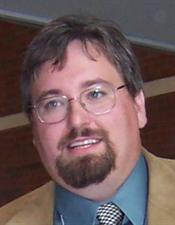
CYTO 2018
-
Register
- Visitor - $200
- Bronze - Free!
- Silver - Free!
- Gold - Free!
- Platinum - Free!
- Community Administrator - Free!
- ISAC Staff - Free!
- Bronze Lab Membership - Free!
- Silver Lab Membership - Free!
- Platinum Lab Membership - Free!
Leadership & Management for SRL Managers
The Facility at the Cutting Edge - How (and Why) to Implement High-End Technologies in the Shared Resource Environment
Antibody Validation for Flow Cytometry
Teaching Methods for SRL Staff: Training the Trainer
Cell Sorting for Function and Viability
Effective Mentoring in a Shared Resource Lab Environment
Mitochondria and Cell Death by Flow Cytometry
How Microbiota Shape the Immune System
Plenary Session 1: Rare and Orphan Diseases
Robert Hooke Lecture: Luminescent Dots for Multiplexing Cytometry and Super-Resolution Imaging
Growing a High-Tech Microfluidics Company: From Lab Bench to Market
-
Contains 3 Component(s), Includes Credits Recorded On: 04/28/2018
CYTO 2018 Robert Hooke Lecture Presented by Dayong Jin, PhD Keywords: CYTO 2018, life-time imaging
About the Presenter
Dayong Jin, PhD
Director
Australian Research Council
University of Technology, SydneyDistinguished Professor Dayong Jin is a former ISAC Scholar. He directs the Australian Research Council IDEAL Research Hub and Institute for Biomedical Materials & Devices (IBMD) at the University of Technology, Sydney. His research has been in the physical, engineering and interdisciplinary sciences. He is a technology developer with expertise covering optics, luminescent materials, sensing, automation devices, microscopy imaging, and analytical chemistry to enable rapid detection of cells and molecules as well as engineering of sensors and photonics devices. Professor Jin is the winner of the Australian Museum Eureka Prize for Interdisciplinary Scientific Research in 2015, the Australian Academy of Science John Booker Medalist in 2017, and the Prime Minister’s Malcolm McIntosh Prize for Physical Scientist of the Year 2017.
Session Summary
Advances in super-resolution fluorescence imaging have enabled revolutionary new insight in the spatial and temporal behavior of the cell. These developments have resulted in a need for the development of robust probes to facilitate long-term tracking of single molecules and real-time super-resolution imaging of sub-cellular structures. In his lecture, Professor Jin will first showcase several new nanotechnology approaches to super-resolution imaging by leveraging optical-switching properties of new classes of luminescent nanoparticles, unlocking new modes of super-resolution microscopy with much higher photon yields than are currently available. He will then summarize his recent achievements by engineering time-resolved photonics devices and reagents to find cells earlier, quicker, and with better resolution.
His achievements include the discovery of the Super Dots for single molecule detection and point-of-care diagnostics; demonstration of a time-domain multiplexing technology for high throughput biotechnology discoveries; creation of the large library of contrast agents for multi-functional bio-imaging and nanomedicine; invention of a low-power, high-contrast super resolution microscopy by achieving the highest optical resolution of 1/36 of the excitation wavelength; and the new development of a microscopy technique, which is aimed at improving the resolution and sensitivity of nanoscale imaging and enables the human eye to track a single molecule and inspect its behavior inside a living cell.
CMLE Credit: 1.0
-
Contains 3 Component(s), Includes Credits Recorded On: 04/28/2018
A CYTO 2018 Plenary Session Presented by Michael Borowitz, PhD & Jonathan Appleby Keywords: Paroxysmal nocturnal hemoglobinuria, GPI anchor, Diagnosis, Red Blood Cell Flow Cytometry, Complement System, Genetic Diseases, ADA-SCID, autologous stem cell gene therapy, clinical trials
The Presenters

Michael Borowitz, PhD
Johns Hopkins Medical Institutions
Jonathan Appleby
GlaxoSmithKline, U.K.Session Summary
Part 1: Paroxysmal Nocturnal Hemoglobinuria: Pathogenesis and Diagnostic Approach
Paroxysmal nocturnal hemoglobinuria (PNH) is a rare disease caused by an acquired mutation of the PIGA gene in a bone marrow stem cell. This gene encodes the enzyme required for the first step in the biosynthesis of the glycophosphatidylinositol (GPI) anchor used to link several proteins to the cell membrane. Among proteins absent in PNH patients, lack of the complement regulatory proteins CD59 and CD55 is responsible for most of the hematologic manifestations of the disease, notably intravascular hemolysis and thrombosis, with consumption of nitrous oxide playing a central role in symptomatology. Patients with this mutation also have bone marrow failure, particularly aplastic anemia, which is produced via different mechanisms. Anti-C5 therapy has revolutionized the management of this disease by preventing the formation of the membrane attack complex on red cells that is otherwise favored as a consequence of CD59 deficiency, thus abrogating intravascular hemolysis and its attendant complications. Flow cytometry has long been recognized as playing an important role in the diagnosis of this disease, as it is deceptively easy to detect loss of GPI anchored proteins with a variety of reagents. In spite of this, early approaches to diagnosis were often problematic, as procedures were not standardized and numerous errors made.
Guidelines published in 2010 outlined principles needed to ensure a good quality assay, but interlaboratory surveys still demonstrated problems with analysis. As a result, a more recent set of guidelines was published that provided far more practical detail about reagent selection, gating strategies, validation principles, quality assurance, and applications in the monitoring of patients. This session will discuss mechanisms of the clinical manifestations of disease, including those not well appreciated in the era before anti C5 therapy, the clinical utility of the flow assays in the diagnosis and management of patients with GPI deficiencies, and key advances in optimizing the performance of flow assays to ensure the maximum benefit to patients with PNH and related disorders.
Part 2: Cell and Gene Therapy in Rare Diseases
Rare diseases are predominantly genetic in nature, present early in life, are frequently serious, and usually lack suitable treatments options for patients. The very high degree of target validation common in rare diseases can remove one challenge associated with medicine development. However, other challenges remain such as the lack of validated disease endpoints, an accurate understanding of disease natural history, and lack of study comparator data.
This presentation will review the opportunities and challenges of working within the field of rare diseases and discuss several recent Advanced Therapeutic Medicinal Product (ATMPs) related breakthroughs. A case study of Strimvelis&[reg] will be presented. Strimvelis was approved in May 2016, and was the first ex vivo stem cell gene therapy to gain marketing authorization in the European Union. The experiences generated, and the precedents created during registration of this innovative medicine will be discussed, as well as a demonstration of creating a path for follow-on treatments with a similar mechanism of action. It is expected that several similar ex vivo hematopoietic stem cell gene therapies currently in development for other severe rare diseases will be registered for marketing authorization in the coming years.
CMLE Credit: 1.0
-
Contains 3 Component(s), Includes Credits Recorded On: 04/28/2018
A CYTO 2018 State-of-the-Art Lecture by Andreas Radbruch, PhD, DRFZ Berlin Keywords: Intestinal microbiota, small particle flow cytometry, Inflammatory Bowel Disease, disease models, Immunoglobulin A
The Presenter

Andreas Radbruch, PhD
Deutsches Rheuma-Forschungszentrum (DRFZ) BerlinSession Summary
Recent evidence shows that distinct bacteria of the microbiota can imprint the immune system of their host decisively, evading immune reactions of their host, and exploiting them against their competitors. Segmented filamentous bacteria, for instance, have been shown to direct T cell differentiation toward Th17 and T follicular helper (Tfh) cell pathways, in immune responses against Citrobacter. In the physiological state, bacteria of the microbiota are exposed to the immune system, but regulatory T cells maintain tolerance. If physiological regulation is impaired, naïve Th cells are activated by microbial antigens, and initiate intestinal inflammation. Even if they start out as Th17 cells, in the end the activated Th cells develop into pro-inflammatory Th1 cells, as we can show by sorting viable Th cells according to cytokine expression ex vivo, for adoptive transfer. In positive feedback loops the activated Th1 cells orchestrate a “type 1” inflammation, by attraction and activation of M1 macrophage/monocytes and granulocytes. The Th1 cells adapt to chronic inflammation by expressing the transcription factor Twist1. The “chronicity gene” Twist1 induces expression of about 70 genes in the pro-inflammatory Th1 cells, genes which control their survival, metabolism, and inflammatory competence.
Originally, it had been described that Th cells require T-bet, the “master transcription factor” of Th1 cells, to be able to induce colitis. Surprisingly, we now can identify distinct microbiotic bacteria, which license T-bet deficient Th cells to induce colitis. These T-bet deficient Th cells induce a “type 2” inflammation, characterized by M2 macrophages. In a personalized approach to patients with inflammatory bowel disease, profiling of the individual microbiota from feces, for bacteria licensing distinct types of inflammation, will provide a non-invasive, fast, and efficient diagnostic tool. “High-Resolution Microbiota Cytometry” can visualize the dramatic changes of microbiota composition in inflammatory bowel diseases, fast and efficiently, and isolate distinct bacteria for functional and molecular analyses. Physiological tolerance of the mucosal immune system is maintained by Th cells expressing the cytokines interleukin-10 and/or “Transforming Growth Factor beta” (TGF-ß). TGF-ß is also the cytokine targeting antibody class switch recombination to immunoglobulin A (IgA) in activated B lymphocytes, the predominant class of mucosal antibodies, able to neutralize pro-inflammatory bacteria.
By serendipity, we have identified a distinct bacterial species of murine microbiota, which induces TGF-&[beta] in intestinal T follicular helper cells, and IgA secreting plasma cells in the lamina propria of the small intestine, resulting in significantly increased mucosal IgA production. This anti-inflammatory bacterium is also present in the microbiota of humans, and its presence correlates to levels of mucosal IgA there.
CMLE Credit: 0.5
-
Contains 3 Component(s), Includes Credits Recorded On: 04/28/2018
A CYTO 2018 Scientific Tutorial Presented by Lara Gibellini, PhD & Jose Enrique O'Connor, PhD Keywords: Mitochondria, Cell Death, JC-1, ROS, Autophagy, Mitophagy, Imaging Cytometry, Apoptosis, Necrosis, Caspase
The Presenters
Lara Gibellini, PhD
University of Modena and Reggio Emilia
ItalyJose Enrique O'Connor, PhD
University of Valencia
SpainSession Summary
Mitochondria are essential organelles for several cellular processes including energy production, calcium homeostasis, reactive oxygen species production, fatty acid oxidation, metabolite synthesis, and regulation of cell death. Given their crucial role in cellular functions, it is not surprising that mitochondrial malfunctions are frequently observed in a number of physio-pathological conditions, including genetic diseases, cancer and aging. Flow cytometry represents one of the most rapid and powerful tool for investigating mitochondrial phenotype at the single-cell level, allowing the generation of multiple information on single cells in a high-throughput manner, with high sensitivity and reproducibility.
This tutorial will introduce users to the main aspects of mitochondrial biology and cell death and will show how flow cytometry can be used to analyze those aspects of cellular biology.
CMLE Credit: 1.5
-
Contains 3 Component(s), Includes Credits Recorded On: 04/28/2018
A CYTO 2018 Scientific Tutorial Presented by Sherry Thornton, PhD & Nancy Fisher, PhD Keywords: professional development, individual development plan, SRL emerging leader program, Marylou-Ingram scholarship program, ABRF mentoring program, career,
The Presenters
Sherry Thornton, PhD
Cincinnati Children's Hospital
USANancy Fisher, PhD
University of North Carolina at Chapel Hill
USASession Summary
The responsibilities of shared resource lab (SRL) directors, managers, and staff are ever changing and evolving. Sharing information and skills through mentoring can aid in quickening the pace at which these individuals can successfully establish or maintain successful SRLs. This tutorial will describe current mentoring programs for SRLs and propose novel ways to engage the mentor/mentee relationship. Many SRL leaders and staff are not educated specifically for these positions, thus, mentor/mentee relationships are crucial to building our SRLs and keeping them strong for the quick pace of research.
After participating in this tutorial, the attendee should be able to:
- Acquire knowledge on mentoring programs that are available to the SRL community.
- Identify novel techniques to engage mentees.
- Identify specific practices that will enhance the mentor/mentee relationship.
CMLE Credit: 1.0
-
Contains 3 Component(s), Includes Credits Recorded On: 04/28/2018
A CYTO 2018 Scientific Tutorial presented by Monica DeLay, Peter Lopez, and Matthias Schiemann Keywords: History, Sorter-Induced Cellular Stress (SICS), sorting conditions, mechanical forces, Sheath buffer, sample buffers, nozzle, pressure, temperature, Instrument type, Sorting time, troubleshoot
The Presenters
Monica DeLay
Cincinnati Children's Hospital
USAPeter Lopez
NYU School of Medicine
USAMatthias Schiemann
Technical University of Munich
GermanySession Summary
The objective of a successful sort is to obtain viable cells functionally representative of the unmanipulated target population. Toward this goal, there are a number of factors to consider depending on cell type and downstream application. This tutorial will review basic guidelines (e.g., buffers, nozzle size, and pressure) that are broadly applicable for obtaining useful sorted product. Specific examples where conditions were optimized for certain cell types will be highlighted. Methods to ascertain cell perturbation as a result of sorting will also be discussed. In addition, attendees are encouraged to bring their relevant experiences to share.
CMLE Credit: 1.5
-
Contains 3 Component(s), Includes Credits Recorded On: 04/28/2018
A CYTO 2018 Scientific Tutorial by Tim Bushnell, PhD Keywords: Learning, Teaching, Training, Learning styles, training programme, training tips, training optimization
The Presenter

Tim Bushnell, PhD
University of Rochester Medical School, USASession Summary
Education is a critical mission for shared resource laboratories. Indeed, in the paper "International Society for Advancement of Cytometry (ISAC) Flow Cytometry Shared Resource Laboratory (SRL) Best Practices," education is highlighted as a key. This includes both education of the staff and education of the end user. Developing an effective training program has two components: the material that is presented and the team that is going to deliver the material.
The goal of this workshop is to help attendees' understand two important factors that can help improve their educational outreach. The first of these components is the different types of learning styles people have. Recognizing and understanding different learning styles will help the trainer adjust their delivery to help the student get maximal benefit from the training. The second of these components is the trainers' teaching styles. Understanding the different training styles will help the trainer appreciate different ways of presenting material, with the goal of providing a more productive program. On top of understanding these different styles are the different modes of presenting information such as a lecture, hands-on discussion, and internet-based tools. Before investing in one method or another, it is important to define the goal of the program and build the platform to serve that goal.
At the end of this tutorial, attendees will have the tools to:
- Identify the learning style of trainees.
- Understand their specific teaching style.
- How to adjust their training style for learning differentiation.
- Evaluate different tools and develop a training program.
CMLE Credit: 1.5
-
Contains 3 Component(s), Includes Credits Recorded On: 04/28/2018
A CYTO 2018 Scientific Tutorial presented by Tomas Kalina, Fridtjof Lund-Johansen, Anis Larbi, Kelly Lundsten, Ruud Hulspas, & Pablo Engel
The Presenters
Tomas Kalina, PhD
Childhood Leukemia Investigation
Prague, Czech RepublicFridtjof Lund-Johansen, PhD
Oslo University Hospital
NorwayAnis Larbi, PhD
Singapore Immunology Network
SingaporeKelly Lundsten
BioLegend
USARuud Hulspas, PhD
Cellular Technologies Bioconsulting LLC
USAPablo Engel, PhD
Department of Cellular Biology and Pathology
University of Barcelona Medical School
SpainSession Summary
Antibody validation in flow cytometry may be a better-established practice than in other antibody applications, particularly in clinical flow cytometry for diagnostic purposes. Antibody validation for flow cytometry was first addressed in 1982 by the Human Cell Differentiation Molecules, an organization that runs the Human Leucocyte Differentiation Antigens (HLDA) workshops to study leukocyte surface molecules. Through these HLDA workshops, information on novel molecules has accumulated rapidly and led to the characterization and formal designation of more than 400 molecules. This has allowed users to put a lot of trust in (albeit a relatively small number) vendors, who are expected to have validated and verified reactivity, specificity, selectivity, and sensitivity in relevant cell populations and cell types. However, best practice demands that the user finds and validates suitable antibodies for any flow cytometric assay, while there is no consensus on acceptable antibody validation methods. Consequently, the validity of flow cytometry results may be put in question.
This tutorial will present the current status of antibody validation from an academic perspective, as well as from the manufacturer perspective. We will discuss current irreproducibility issues and their relevance to cytometry. We will summarize the needs and challenges specific to flow cytometry, and we will discuss future methods needed for antibody validation.
CMLE Credit: 1.5
-
Contains 3 Component(s), Includes Credits Recorded On: 04/28/2018
A CYTO 2018 Scientific Tutorial Presented by Vinko Tosevski, PhD, University of Zurich Keywords: SRL, Cytof, reagent repository, validated panels, data analysis
The Presenter

Vinko Tosevski, PhD
University of Zurich, SwitzerlandSession Summary
Centralized provision of research infrastructure in the form of capital equipment and/or scientific expertise has been around in one form or another since the invention of flow cytometry. Initially necessitated by the novelty of the instrumentation, it is recognized today as a high-quality and cost-effective solution bridging research scientists and technological resources required to drive novel discoveries. The format of such a shared facility will be dictated by the requirements and provisions of the hosting institution, but two general concepts can be recognized. Service-focused establishments that house capital equipment are dubbed "core facilities" or simply "cores" while more comprehensive facilities boasting both technical and scientific expertise are dubbed "shared resource laboratories" (SRLs).
The technological and methodological sophistication required to advance the biomedical research today takes skill, time, and effort to master. With doctoral and postdoctoral positions being limited in duration, institutions are challenged with maintaining the expertise and utilizing it in a time- and cost-effective manner. This is where shared resource laboratories make their largest contribution. Building on the same premise, SRLs are perfectly positioned to be among the first ones to implement and disseminate novel technologies. And yet, such an effort is not without the challenge.
Here we share founding ideas, performance metrics, and experiences gathered at the Mass Cytometry SRL at the University of Zurich. Structured as an one-stop-shop for mass cytometry projects, we were among the first SRLs in Europe to provide comprehensive support for conducting research with a novel high-dimensional single cell methodology. By providing first-hand experiences and solutions to budgetary, scientific, and technological challenges, we hope to promote information exchange and provide references facilitating similar operations elsewhere.
After participating in this tutorial, the student will have an extended appreciation of how SRLs can be effective partners in furthering their own research. Also, SRLs will be presented as desirable and competitive career paths at the forefront of the discovery, demonstrated by numerous real-life examples.
CMLE Credit: 1.0
-
Contains 3 Component(s), Includes Credits Recorded On: 04/28/2018
A CYTO 2018 Scientific Tutorial Presented by Derek Davies, Francis Crick Institute Keywords: Training, Mentorship, Heterogenity, Teamwork, Delegation, Communication
The Presenter

Derek Davies
The Francis Crick Institute, United KingdomSession Summary
Core facilities, or shared resource laboratories (SRLs), can grow from a simple start. It may just be one person looking after one to two pieces of equipment, training users, and developing the core. But as an SRL grows, there is a need to recruit staff. Choosing the correct people for the job is a skill that we are not taught and it often relies on the intuition of the hiring manager. Once in place, an SRL manager will have responsibility for the development of that staff member which will include competency training, responsibility for provision of personal development as well as performing one or more specific functions within the laboratory. Often new managers arrive with staff already in place who may be used to different management styles and have varying expectations, skill sets, and needs.
All these situations require leadership and management knowledge. Many of us who run SRLs have no formal training in aspects such as how well the SRL is viewed by management or the institute; the staff's perspective on the structure of the lab; a clear pathway for the lab (introduction of new technology, increased user-base, and increased profile through the local to the international levels); and space for personal development. There is also the issue of dealing with the management structure above the SRL.
Managers and staff will have expectations. There is not a "one size fits all" solution. Nor is that solution the same depending on institutional setting (e.g., university vs. research institute vs. contract research lab vs. biotech). Using anecdotal evidence gathered over 20 years of managing a flow cytometry facility, this presentation will cover the important points that must be considered to successfully manage and lead a facility as well as being able to liaise with upper management. At the end of the session, attendees should have a greater appreciation of the range of skills needed to lead a successful SRL.
CMLE Credit: 1.5

